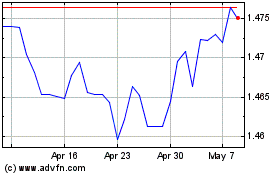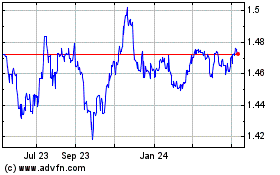Euro Higher After ECB Weidmann Calls On To Start Exiting Stimulus
August 23 2018 - 4:29AM
RTTF2
The euro was higher against its major counterparts in the
European session on Thursday, after Deutsche Bundesbank President
Jens Weidmann said that the European Central Bank must not postpone
the normalization of monetary policy.
"It's also time to begin exiting the very expansionary monetary
policy and the non-standard measures, especially considering their
possible side effects," Weidman said in a speech at the Berlin
Foreign Press Club.
"This normalization process will probably take place only
gradually over the next few years. That's exactly why it has been
so important to actually get the ball rolling without undue delay,"
he said.
The minutes from the recent monetary policy meeting showed that
the euro area economy was proceeding along a solid and broad-based
growth path and the risks surrounding the euro area growth outlook
remained broadly balanced, but uncertainties related to global
factors remained prominent.
Members broadly agreed that an ample degree of monetary policy
accommodation was still necessary to support the further build-up
of domestic price pressures and headline inflation over the medium
term.
Flash data from IHS Markit showed that the euro area private
sector continued to expand in August, albeit with the rate of
expansion remaining one of the weakest seen over the past
year-and-a-half.
The composite output index rose marginally to 54.4 in August
from 54.3 in July. But the score was slightly below the forecast of
54.5.
The currency traded mixed against its major counterparts in the
Asian session. While it fell against the greenback and the franc,
it held steady against the yen and the pound.
The euro advanced to a 2-week high of 128.43 against the yen,
and held steady thereafter. On the upside, 130.00 is likely seen as
the next resistance level for the euro.
Figures from the Cabinet Office showed that Japan's leading
index weakened more than initially estimated in June.
The leading index, which measures the future economic activity,
dropped to 104.7 in June from 106.9 in May. The preliminary score
for June was 105.2.
The single currency bounced off to 1.1590 against the greenback,
from a 2-day low of 1.1542 seen at 12:00 am ET. The euro is likely
to challenge resistance around the 1.17 level.
Data from the Labor Department showed a modest decrease in
first-time claims for U.S. unemployment benefits in the week ended
August 18th.
The report said initial jobless claims edged down to 210,000, a
decrease of 2,000 from the previous week's unrevised level of
212,000. Economists had expected jobless claims to inch up to
215,000.
The 19-nation currency edged up to 0.8994 against the pound,
after having fallen to 0.8970 at 8:45 pm ET. The next likely
resistance for the euro is seen around the 0.92 level.
The latest quarterly Distributive Trades Survey from the
Confederation of British Industry showed that UK retailers reported
an above-average sales growth in the year to August but the outlook
was less positive with declines in employment, investment intention
and business optimism.
A net balance of 29 percent said their sales volumes increased
in August. However, the balance for the next month fell to 22
percent.
The euro recovered to 1.1388 against the franc, from a 2-day low
of 1.1365 touched at 5:00 am ET. If the euro rises further, 1.16 is
likely seen as its next resistance level.
The 19-nation currency firmed to near a 2-week high of 1.7358
against the kiwi and a 3-1/2-month high of 1.5898 against the
aussie, reversing from its early lows of 1.7281 and 1.5757,
respectively. The euro is poised to find resistance around 1.75
against the kiwi and 1.61 against the aussie.
The euro, having fallen to a 2-day low of 1.5055 against the
loonie at 8:45 pm ET, reversed direction and ticked higher to
1.5114. The euro is likely to challenge resistance around the 1.52
level.
Looking ahead, U.S. new home sales for July and Markit's
preliminary manufacturing PMI for August are slated for release
shortly.
At 10:00 am ET, Eurozone advanced consumer confidence index for
August will be out.
Euro vs CAD (FX:EURCAD)
Forex Chart
From Mar 2024 to Apr 2024

Euro vs CAD (FX:EURCAD)
Forex Chart
From Apr 2023 to Apr 2024
